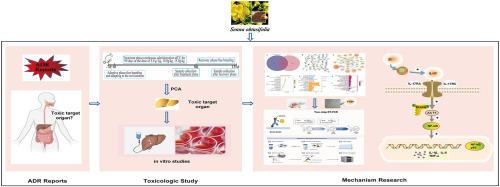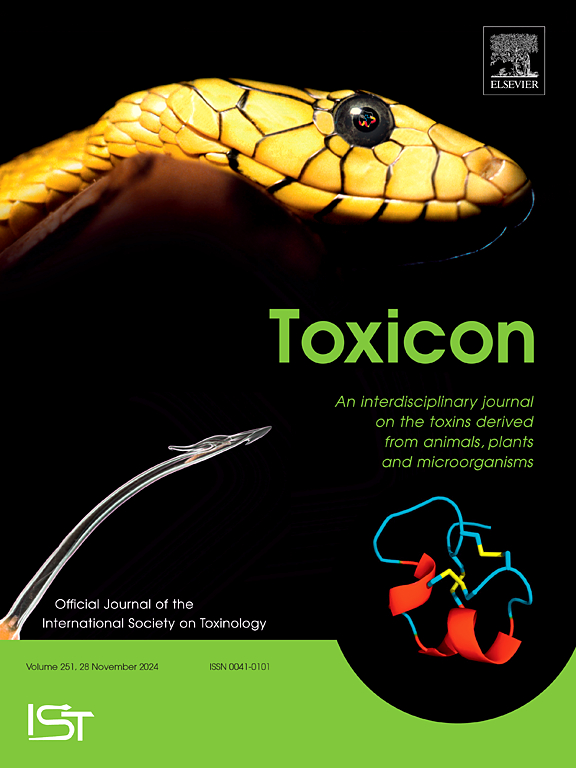番泻叶水提取物的转化毒理学研究
IF 2.6
4区 医学
Q2 PHARMACOLOGY & PHARMACY
引用次数: 0
摘要
近年来,番泻叶的临床药物不良反应(ADR)报告不断涌现,尤其是肝毒性。然而,肝脏是否是唯一或主要的毒性靶器官尚不清楚。在本研究中,我们对番泻叶水提取物(SE)进行了重复给药实验,并使用 PCA 分析来确定主要毒性靶器官。结果显示,肝脏是主要的毒性靶器官,我们还在体外验证了肝毒性。利用网络毒理学技术预测了肝毒性的机制,并通过 ELISA、qPCR、Western 印迹等方法进行了验证。结果表明,SE能提高大鼠肝脏和HepG2细胞中血清TNF-α、IL-6、IL-1β的水平,ACT1、TRAF6、NF-κB P65的mRNA表达水平,以及TRAF6、NF-κB P65、P-P65的蛋白表达水平,这表明SE诱导的肝毒性可能与炎症反应有关。本文章由计算机程序翻译,如有差异,请以英文原文为准。

Study on Translational toxicology of Senna obtusifolia aqueous extract
In recent years, the clinical adverse drug reactions (ADR) reports of Senna obtusifolia have been constantly emerging, especially hepatotoxicity. However, it is unclear whether the liver is the only or main toxic target organ. In this study, we conducted a repeated administration experiment with the Senna obtusifolia Aqueous Extract (SE) and PCA analysis was used to determine the primary toxic target organs. The results revealed that the liver was the main toxic target organ and we also verifid the hepatotoxicity in vitro. The mechanism of hepatotoxicity was predicted by network toxicology technology, which was verified by ELISA, qPCR, western blotting and other methods.The results showed that SE could increase the serum levels of TNF-α, IL-6, IL-1β, the mRNA expression levels of ACT1, TRAF6, NF-κB P65 and the protein expression levels of TRAF6, NF-κB P65, P-P65 in rat livers and HepG2 cells, which indicated that SE induced hepatotoxicity might be related to inflammatory response.
求助全文
通过发布文献求助,成功后即可免费获取论文全文。
去求助
来源期刊

Toxicon
医学-毒理学
CiteScore
4.80
自引率
10.70%
发文量
358
审稿时长
68 days
期刊介绍:
Toxicon has an open access mirror Toxicon: X, sharing the same aims and scope, editorial team, submission system and rigorous peer review. An introductory offer Toxicon: X - full waiver of the Open Access fee.
Toxicon''s "aims and scope" are to publish:
-articles containing the results of original research on problems related to toxins derived from animals, plants and microorganisms
-papers on novel findings related to the chemical, pharmacological, toxicological, and immunological properties of natural toxins
-molecular biological studies of toxins and other genes from poisonous and venomous organisms that advance understanding of the role or function of toxins
-clinical observations on poisoning and envenoming where a new therapeutic principle has been proposed or a decidedly superior clinical result has been obtained.
-material on the use of toxins as tools in studying biological processes and material on subjects related to venom and antivenom problems.
-articles on the translational application of toxins, for example as drugs and insecticides
-epidemiological studies on envenoming or poisoning, so long as they highlight a previously unrecognised medical problem or provide insight into the prevention or medical treatment of envenoming or poisoning. Retrospective surveys of hospital records, especially those lacking species identification, will not be considered for publication. Properly designed prospective community-based surveys are strongly encouraged.
-articles describing well-known activities of venoms, such as antibacterial, anticancer, and analgesic activities of arachnid venoms, without any attempt to define the mechanism of action or purify the active component, will not be considered for publication in Toxicon.
-review articles on problems related to toxinology.
To encourage the exchange of ideas, sections of the journal may be devoted to Short Communications, Letters to the Editor and activities of the affiliated societies.
 求助内容:
求助内容: 应助结果提醒方式:
应助结果提醒方式:


